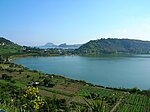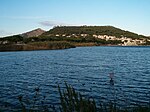Licola, Pozzuoli

Licola is an area in the province of Naples which takes its name from Lago dei Follicoli, a lake which formerly occupied most of the area. The current population of Licola ranges between 4,000 and 5,000. Licola is a strip of land facing the sea, and is roughly three kilometers by ten kilometers in size. It begins at the foot of Mount Cuma and ends in Marina di Varcaturo. The Licola area is divided between two municipalities. In particular, the southern part is divided between the villages Licola Center (also known as Licola Village) and Licola Lido (also known as Lido di Licola) of the municipality (or comune) of Pozzuoli, bordering the Arco Felice section of the municipality. The northern part, Licola Mare, is part of the hamlet of Varcaturo, which is a section of the municipality of Giugliano, part of the constituency of Licola-Lago Patria. The town revolves around Piazza San Massimo, which is the oldest square in the town.
Excerpt from the Wikipedia article Licola, Pozzuoli (License: CC BY-SA 3.0, Authors, Images).Licola, Pozzuoli
Piazza San Massimo,
Geographical coordinates (GPS) Address Nearby Places Show on map
Geographical coordinates (GPS)
| Latitude | Longitude |
|---|---|
| N 40.870027777778 ° | E 14.060472222222 ° |
Address
Piazza San Massimo
Piazza San Massimo
80072
Campania, Italy
Open on Google Maps







